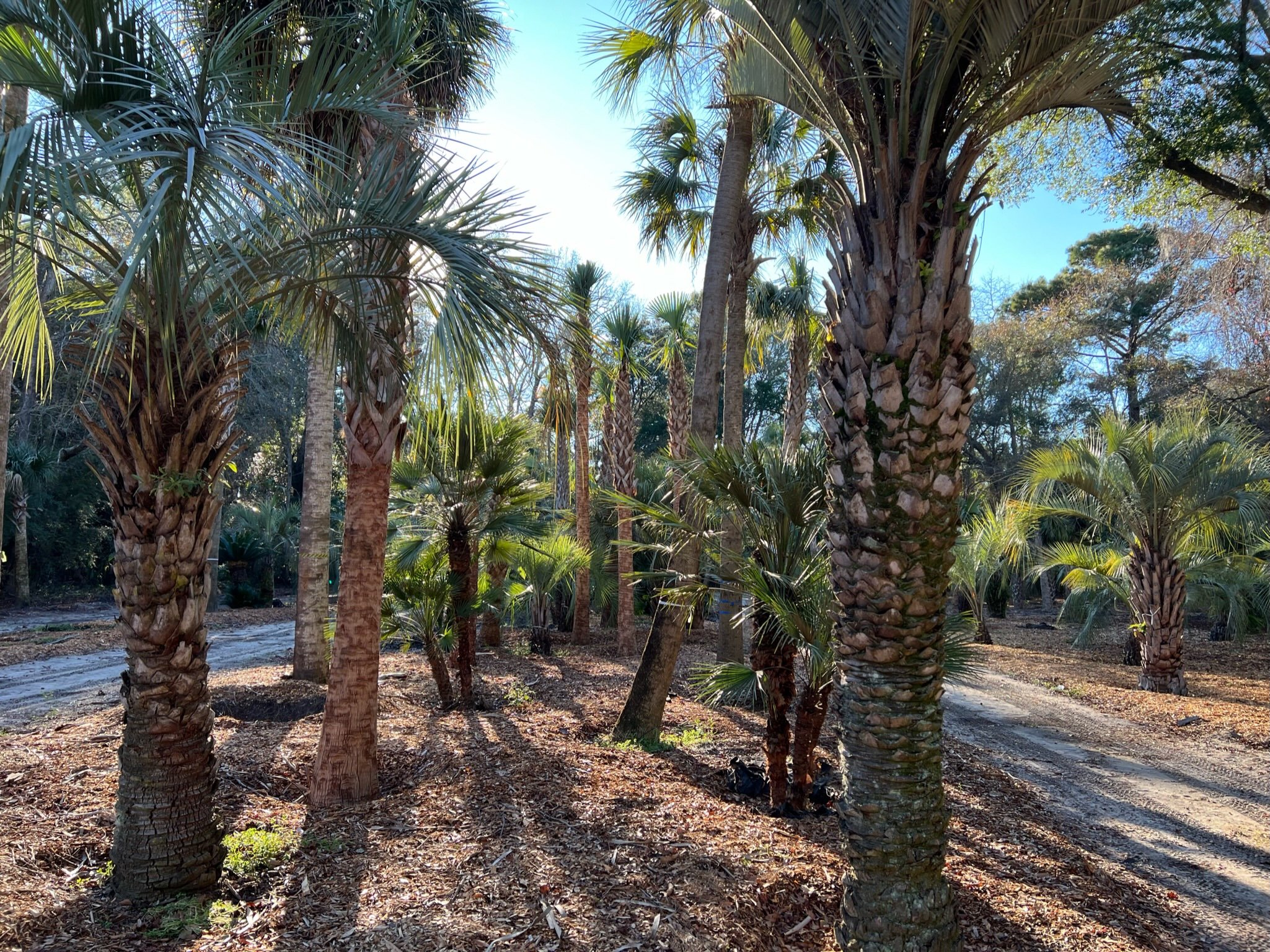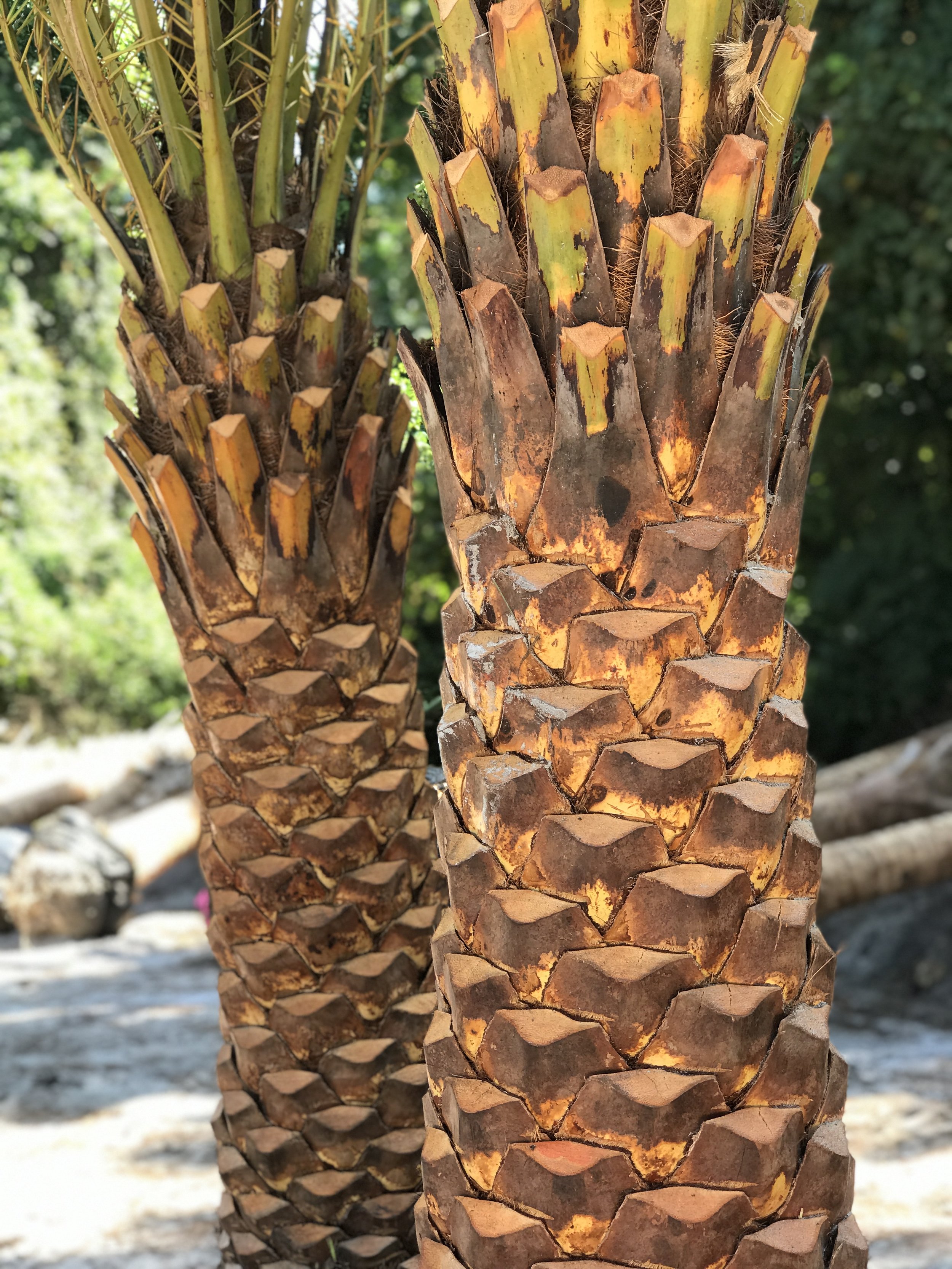
THE PALM CATALOG
Your complete guide to our extensive offering of trees and plants
Quick Links
Upright Palms
Palmetto Palm (Sabal palmetto)
Other Names: Cabbage Palm
This palm tree, commonly seen near the coast, has large, blue-green costaplamate leaves with a distinctive, large notch in the middle. Trees from southern Florida have larger, more elliptical leaves. The trunk is large (can be a foot and a half across) and wild palmettos retain old frond bases on their trunks in a crisscross pattern, typically called "boots". These are sometimes removed on cultivated plants.
Pindo Palm (Butia capitata)
Other Names: Jelly Palm
A feathery palm with a massize trunk up to 2' in diameter, with gray-green to blue-green fronds that can be 6'-8' feet long. The Pindo is one of the only feather palms commonly grown in the Southeast.
Canary Island Date Palm (Phoenix canariensis)
Other Names: Pineapple Palm
Very formal in appearance with a single, large canopy of 50-150 stiffly arched fronds. Has a spiny, diamond shaped pattern to the trunk. This is a very slow growing tree and is very drought resistant.
Sylvester Date Palm (Phoenix sylvestris)
Other Names: Silver Date Palm
Very similar to the Canary Island Date Palm, the Sylvester Date is a massive tree with a beautiful reddish trunk and large canopy of up to 100 fronds as long as 9 feet. Often their trunks are cut to show off a uniform pattern of diamond shaped boots.
Mexican Fan Palm (Washingtonia robusta)
A large palm with a trunk up to two feet across. Leaves are yellow/green and palmate with spiny stems. Leaves have numerous threads hanging between the leaf segments. If not pruned off, dead leaves persist almost indefinitely.
Windmill Palm (Trachycarpus fortunei)
A single trunk palm tree, with about 20 leaves. The leaves are fan-shaped and are similar to needle palm leaves. The slender (1 foot or less diameter) trunk is brown and is usually covered with a burlap-like texture. The trunk is often wider at the top than at the bottom.
LIMITED AVAILABILITY BASED ON SIZE. LARGER SIZES IN SHORT SUPPLY.
European Fan Palm (Chamaerops humilis)
Other Names: Mediterranean Fan Palm
A small, clumping palm with stiff leaves and spiny leaf stems
Ribbon Fan Palm (Livistona decipiens)
Other Names: Weeping Cabbage palm
The ribbon fan palm has graceful fronds which hang down for several feet. The fronds have many folded and divided segments which create the beautful weeping effect. The stems are long and edged with small, sharp spines. The aged trunks lose their boots and have a smooth, mahogany look and feel. The flowers are yellow.
Chinese Fan Palm. (Livistona chinensis)
Other Names: Fountain Palm
The Chinese fan palm is a subtropical tree from east Asia, native to Japan, Taiwan, and southeastern China, with large fan-shaped leaves.
Mule Palm (Butiagrus nabonnandii)
A hybrid of the Pindo Palm and the Queen Palm, the Mule Palm is very frost hardy and grow rapidly in sun or light shade.
Low Growing Palms
Dwarf Palmetto (Sabal minor)
Sometimes described as a clumping plant, but really only has one trunk, which is either very short or entirely below ground. Leaves are palmate or slightly costa-palmate and vary from green to blue-green in color, with usually no more than a half-dozen on a single plant. They differ from the leaves of other native dwarf palms by having a split "V" right in the middle.
Needle Palm (Rhapidophyllum hystrix)
A Clumping, under story palm with many palmate, deep-green leaves that have silvery undersides. Its crown is protected by numerous and very sharp needles, hence the name.
Saw Palmetto (Serenoa repens)
A low, spreading fan palm with stiff leaves and spiny leaf stems. Its trunks usually creep along the ground, rooting and branching as they grow. In coastal regions, it is an aggressive spreader. The only native palm with spiny leaf stems. Plants in our area have yellow-green leaves. Some plants from southeastern Florida have blue-green or silvery leaves.
Lady Palm (Rhapis excelsa)
A beautiful shrub-like palm that can be used both as an indoor or outdoor palm. Grows in clusters, similar to bamboo.
Cycads
King Sago Palm (Cycas revoluta)
A rugged trunk, topped with whorled, stiff, feather-like leaves growing in a circular pattern. Rather than continuously adding foliage, Sago's produce a periodic "flush" of new leaves, called a "break". Eventually, offsets begin to grow at the base of the specimen, and occasionally in the crown. The addition of offsets provides a source of new plants and many possibilities for developing a unique specimen.
Coontie Palm (Zamia integrifolia)
Other Names: Florida Arrowroot, Wild Sago, Indian Bread Root.
The Coontie has delicate looking, pinnate leaves with 6-20 pairs of flat, oblong leaflets. There are inconspicuous teeth near the tips.
Bamboo
Alphonse Karr (Bambusa multiplex alphonse karr)
This plant has tight clumps of yellow with green striping. New culms have a reddish blush color, especially when exposed to a lot of sun. Provides excellent screening, and is non-invasive.
Golden Goddess (Bambusa multiplex golden goddess)
This bamboo has yellowish culms and is a non-invasive clumping bamboo that provieds excellent screening. Similar to the Alphonse Karr.
Graceful Bamboo (Bambusa textilis gracilis)
Other Names: Slender Weaver
A tight-clumping, fast-growing bamboo native to Southern China, with small leaves that are great for screening.































































